
|

|
Viking Age Arms and Armor
Viking Shields
 |
Much of the text presented on this page is out-of-date. Until we find time to make the needed updates to this page, we strongly encourage readers to look at this topic as it is presented in our new book, Men of Terror, available now from your favorite book seller. |
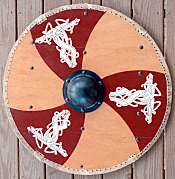 |
In the Viking age, fighting men used large, round, wooden shields gripped in the center from behind an iron boss. A reproduction shield is shown to the left, and a historical shield from the Oseberg ship to the right. Shields represent one of several instances where the literary sources and archaeological sources do not agree on how Viking weapons were constructed. The Norwegian Gulaţing and Frostaţing laws specify the construction of a shield. The shield should be made of wood with three iron bands and a handle fastened to the back side by iron nails. A later revision of the law says that the shield should be made of a double layer of boards (tvibyrđr), and the front should be painted red and white. |
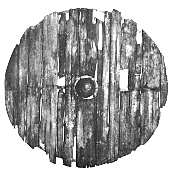 |
A few shields have survived from the Viking age, notably the shields from the Gokstad ship, which date from the 10th century. The ship was equipped with 32 shields, several of which survive intact. They were made from a single layer of planks butted together, with no iron bands, and the fronts were painted black and yellow.
Typical Viking shields were 80-90cm (32-36 inches) in diameter. Some were larger, such as the Gokstad shields, which were 94cm (37in) across. Based on surviving remnants, some shields appear to have been as small as 70cm (28in) in diameter. Presumably when a man made a shield for himself, he sized it to fit his body size and fighting style. A shield needs to be big enough to provide the desired protection but no bigger. A shield too small exposes additional lines of attack that an opponent might exploit, while a shield too large slows the defensive responses and exhausts the fighter unnecessarily.
All the surviving examples are made from solid butted planks, although literary evidence, such as the 10th century Frankish poem Waltharius, and the Gulaţing laws, suggests that shields were made of laminated wood. No archaeological evidence supports this style of construction during the Viking era in Norse lands.
Surviving shields are made from spruce, fir, or pine. Again, literary evidence contradicts and suggests that shields were made with linden wood (Tilia, commonly known as basswood in North America). The word lind (linden) is used to mean "shield" in poems such as Völuspá (50), and the term lindiskjöldr (linden shield) is used in some sagas. Linden certainly has advantages over other species of wood for shield use. It is lightweight and does not split as readily under impact as do other types of wood.
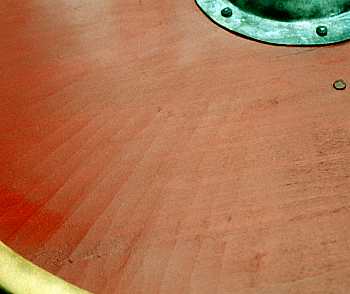 |
The Gokstad shields were approximately 7mm (1/4in) thick near the center and were chamfered so they were thinner at the edges. Most surviving shields are in the range between 6mm (1/4in) and 12mm (1/2in) thick, although shields thicker than 30mm (1-1/8in) have been found. Egils saga (chapter 53) says that Ţórólfr was equipped with a large, thick shield. Later in the battle, he threw his shield on his back to wield his spear with two hands. The reproduction shield shown to the left is chamfered so that it is about 12mm (1/2in) thick in the center and 6mm (1/4in) at the edges. The marks of the tool used to shave off the thickness on the shield face are clearly visible in the photo. |
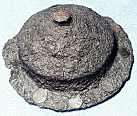 |
At the center of the shield was a domed iron boss, which protected the hand. A 10th century shield boss found at Hemla in south Iceland is shown in the photo to the right. The boss shown to the left is from the earlier Vendel period, but this style with its long neck and knob at the apex was also used in the Viking age. The many nails on the flange that held the boss to the shield are visible. |
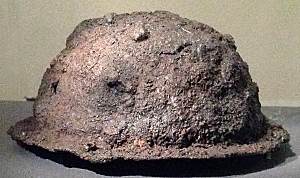 |
It has been suggested that the neck and knob were used to catch and trap incoming sword blades, allowing the blade to be twisted out of the opponent's hand, or possibly to be snapped in two.
|
Bosses were typically 15cm (6in) in diameter and had a thickness of 3 to 5mm (about 0.1 to 0.2in, or between 6 and 10 gauge). The boss must be large enough to comfortably admit the hand and allow the shield to shift freely around the hand as the combatant moves the shield from one side to the other. Earlier bosses were hemispherical, while later bosses were more flattened. Some bosses had a cylindrical neck between the flange and the dome, such as the Vendel era boss shown above and to the right. Flanges were usually round, although bosses with more elaborately shaped flanges, such as toothed flanges, have been found. |
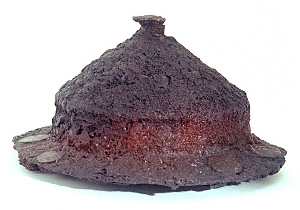 |
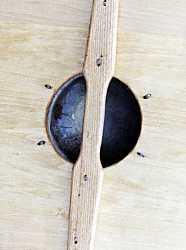 |
Broad headed iron nails passed through the flange and were either flattened, or clenched (bent over) on the reverse side of the shield to hold the boss in place. The clenched nails on the reverse side of a reproduction shield are visible in the photo to the left. Like the Gokstad shields, this reproduction shield has no iron reinforcements, and a single wooden handgrip running across the diameter of the shield. The shield was gripped from the inside of the boss, as shown to the right. The arm did not slip through any straps, and as a result, the shield could be rotated freely from side to side. |
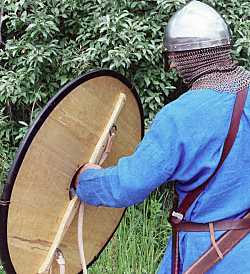 |
At least one passage from the sagas can be used to dispute this interpretation of the handgrip. In chapter 32 of Bjarnar saga Hítdćlakappa, the author says that Björn held the shield with his arm through the hand-grip (Björn hélt á skildinum svá at handleggr hans var í mundriđanum...).
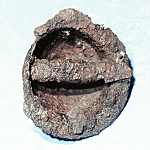 |
The interior of the Vendel era boss is shown to the left. This boss has a handgrip riveted to the inside of the boss. Clearly, no arm could pass through this handgrip. |
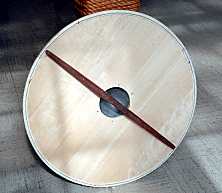 |
The handgrip typically ran the full diameter of the shield. Many shields used a simple wooden handgrip, as shown on the reproduction shield to the left, while some used wood in combination with iron, nailed to the shield, as shown in the reproduction shield to the right. Some of the surviving iron handgrips are decorated with silver or bronze. Although the Gulaţing laws required three iron reinforcing bars on the back of the shield (right), archaeological evidence is very slight. If they were used at all, these reinforcements would have added strength to the shield and served to hold the plywood or planking together. |
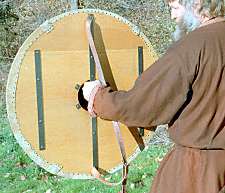 |
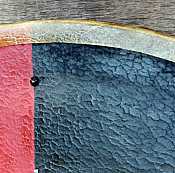 |
The shield was probably rimmed with leather or rawhide (left) to keep the shield from splitting when hit on edge. The edging helped to bind the shield together, as well, since the leather shrunk after it was installed, forcing the planks more tightly together. The benefits of this kind of edging are shown graphically later on this page. |
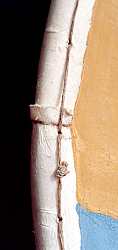 |
The Gokstad shields have a series of small holes all around the periphery of the shields. They're about 20mm (3/4in) in from the edge, spaced at 35mm intervals (1-3/8in). It is thought that the leather edging was held in place on these shields either with iron nails, or with stitching that passed through these holes, as shown on the reproduction shield to the left. Some shields have evidence of iron or bronze clamps around the edge, perhaps to hold the leather edging in place. A speculative reconstruction of an iron clamp is shown to the right. Occasionally, these clamps were not uniformly distributed around the edge of the shield, suggesting that they were used to reinforce and protect a damaged edge. |
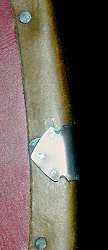 |
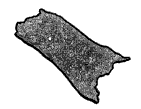 |
There is negligible archaeological evidence for iron-rimmed shields, although in chapter 40 of Grettis saga, it is said that a berserk carried an iron-rimmed shield to a duel against Grettir. When Bersi and Steinar dueled in chapter 12 of Kormáks saga, Bersi's sword stuck in the iron rim of Steinar's shield. A highly speculative interpretation of an iron-rimmed shield is shown to the right. The shield fragment found at Baldursheimur in north Iceland sketched to the left has been interpreted as either a fragment of a shield rim, or as a fragment of a reinforcement on the rear of the shield. With so little of the original left to go on, either interpretation seems speculative. The fragment is just 8.5cm (3.5in) long. |
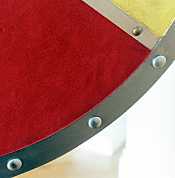 |
|
A leather sling, used to carry the shield over the shoulder (right), would have been common. There are many instances in the stories in which a fighter threw his shield over his back in order to wield his weapon with two hands, such as in chapter 53 of Egils saga. During a battle against Earl Hringr, Ţórólfr threw his shield over his back and thrust with his spear using both hands, eventually thrusting it through the earl's chest and out his back. Shields were slung over the shoulder when not in combat, as well. In chapter 14 of Gull-Ţóris saga, Ţórir went out to trim the manes of his horses. He worked with his shield hanging by his side. Bljúgr attacked unexpectedly, thrusting at Ţórir with his spear. The spear glanced off the shield and entered the horse's belly, killing the animal. The sling could sometimes be a dangerous nuisance. Bjarnar saga Hítdćlakappa (chapter 18) says that Eyvindr attacked Björn with his axe. The attack hit Björn's helmet and glanced off, but the back of the axe caught Björn's shield strap, redirecting the blow into his chest. Björn received minor wounds in his chest and leg from the attack. Björn threw his shield away, and struck at Eyvindr, causing his death. |
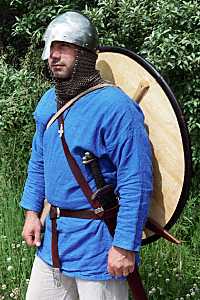 |
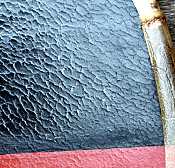 |
The front of some shields may have been covered with leather. The leather made the shield more resistant to the impact of weapons, although it also added significant weight. The grain of the leather facing in the reproduction shield to the left is clearly visible through the paint. The benefit of a facing such as this is shown graphically later on this page. Alternatively, shields may have been faced with linen, held in place with hide glue, as was done on the reproduction shield shown to the right. The linen adds negligible weight, but the fibers greatly strengthen the wood, holding the structure together even if the wood splits. Some surviving shields show evidence of paint (mineral pigments ground into an oil base) on the wood surface, suggesting that they were not covered. Either way, shields were probably painted and decorated. The shields on the Gokstad ship were painted black and yellow. A Viking-age shield recently found at Trelleborg was painted red and white, in accordance with the requirements of the old Norwegian law codes. The sagas suggest that carrying a red shield signaled hostile intent (e.g., Eiríks saga rauđa chapter 11). |
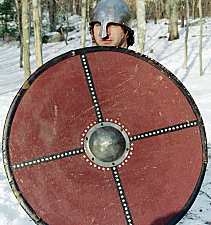 |
Even if a shield were not decorated, it is highly likely that it would be sealed with oil so that it repelled and resisted water. A shield that soaked up water from rain or sea spray could easily double in weight, becoming so heavy and waterlogged as to be nearly useless.
The thin, unfaced reproduction shields shown in the photographs on this page weigh about 5kg (11lbs), while the thicker, leather covered shields weigh more than 7kg (15lbs) when dry.
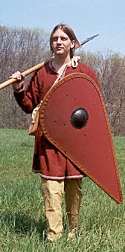 |
At the end of the Viking era, kite shields were used, shown in the photo to the left and illustrated in the Bayeux Tapestry (right). Their shape helped protect a fighter while riding on the back of a horse. However, during the Viking age, fighting was done on foot, so it seems unlikely they would have seen wide use. Evidence from skaldic poetry suggests round shields. Snorri Sturluson, writing well after the Viking age, says that in earlier times, shields were decorated on the border called the circle (baugr, which also has the meaning of "ring"). Thus, Snorri says that in poetry, shields should be referred to as a circle, suggesting that shields were round. Snorri gives several examples of verse which use this reference (Skáldskaparmál 49). |
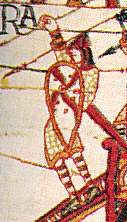 |
Episodes in the sagas can be quoted to dispute this conclusion. One of these occurs in chapter 129 of Brennu-Njáls saga, where Helgi struck out with his sword and cut off the tip of his opponent's shield, as well as his opponent's leg. Round shields can scarcely be said to have "tips", suggesting that the shield in question was a kite shield. However, the significant word in the original Icelandic is sporđr, a word with multiple meanings. Some modern translations render this as "lower part of the shield", but "tail of the shield" also fits.
|
Other kinds of shields are mentioned in the sagas, including targa (target) and buklari (buckler), although it's not clear from the stories how these differed from normal shields (skjöldr). In translation, the two words are usually rendered as "small shield." Targets and bucklers are small shields known to have been used in later historical periods, although targets became larger in the Renaissance. The photo shows a buckler technique taught in the 14th century combat manual, Royal Armouries MS I.33. Since the buckler protects against only one line of attack, the manual teaches that it is used to protect the sword hand. Overwhelmingly, the archaeological evidence, although sparse, supports only the use of large round shields in the Viking age. Perhaps the saga language that suggests the use of kite shields or small shields is an anachronism, an error in which the saga author placed later shields from his own era into the earlier Viking era about which he was writing. |
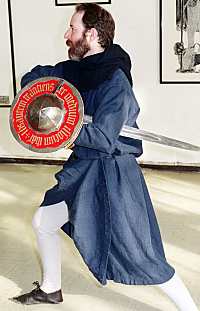 |
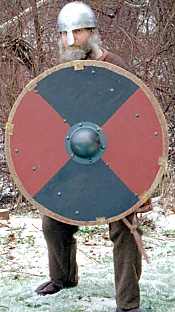 |
The Viking shield is a very effective defense. It is worth noting that a shield does not absorb the shock of the blow. Rather, it redistributes the shock over a larger area, making it possible for the human body to absorb the force of the blow with reduced risk of injury. Additionally, the shield can be used to push an attack off-line, so that the attack is no longer a direct threat. The shield blocks many lines of attack simultaneously. In a neutral, relaxed position, the shield protects from neck to knees (left). The head and the lower legs are exposed and unprotected. Thus, the head and lower leg were likely targets. While the shield can be moved rapidly to ward off blows coming in from a variety of directions, studies of skeletal remains show that many battle injuries occurred to the head and legs. For example, the photo to the right shows the skull of an 11th century fighting man who was about twenty years old at the time of his death. The top of the skull was removed by a blow from a sword. The terminus of the blow is indicated in the photo by the clear blade. Leg injuries visible in the skeletal remains from Fishergate (York) suggest deliberate attempts to sever the leg muscles, causing the combatant to fall without killing him. |
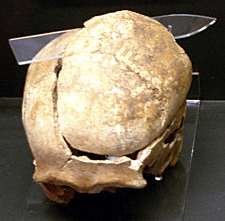 |
Offensive weapons sometimes stuck fast in a shield after a blow. When that happened, a clever fighter could twist his shield either to break the weapon, or to break it loose from the grip of its owner. In chapter 150 of Brennu-Njáls saga, Kári caught a spear thrust with his shield, then snapped the spear by wrenching his shield.
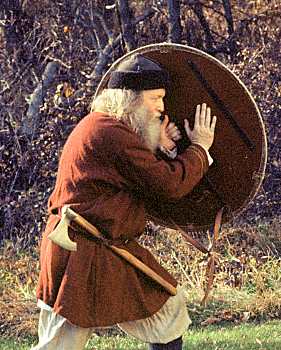 |
The sagas suggest that the shield might be used two handed to defend against a powerful attack. In chapter 55 of Laxdćla saga, Bolli saw Helgi prepare for a thrust with his spear. Bolli dropped his sword to hold the shield with both hands. This trick did not stop Helgi's spear from penetrating the shield and wounding Bolli. In chapter 24 of Grettis saga, Gunnar held his shield with two hands against an attack by Grettir. The trick didn't work in this case, either. Grettir hacked with his sax between Gunnar's body and the shield, cutting off both of Gunnar's hands. A speculative reconstruction of two-handed use of the shield is shown in this combat demo video, part of a longer fight. |
Occasionally, men dropped their shields in battle because they temporarily needed a free hand for some other purpose. When Grani shot a spear at Kári, as is told in chapter 150 of Brennu-Njáls saga, Kári jammed his shield into the ground so hard that the shield stood up by itself. With his free hand, Kári grabbed the spear in flight and fired it back at Grani, and then snatched his shield back up, all while holding his sword in the other hand. The spear found its mark, and Grani was seriously wounded.
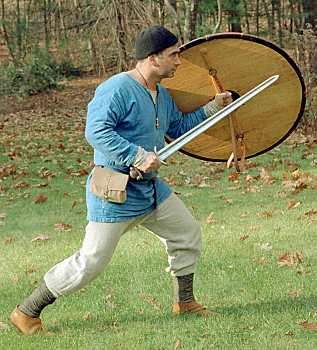 |
Many people think of a shield as a wall to hide behind. While shields can be used passively in that manner, a more aggressive posture and use are advantageous. In single combat, the shield was probably held at an angle to the body, either to the outside (to the left side for a right-handed man) or inside (to the right side). The shield is held forward, but not in front of, the combatant, contacting hand, arm, and shoulder and becoming a part of the combatant's body. Too far forward results in a slower, less powerful and less effective defense that wastes the combatant's physical resources. |
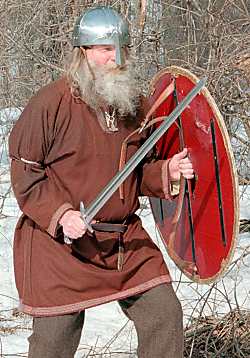 |
|
This stance puts the combatant in an aggressive position with good defensive options. The aggressive posture moves the line of defense well away from the body. Attacks can be parried or deflected or broken up well before they reach the body. The angle prevents the shield from being driven straight in to the combatant's body, which might pin his arms and limit his options. The angle also allows incoming blows to be deflected, rather than being caught straight on. Deflecting the blow, rather than stopping it, puts less force on both the shield, and the combatant's arm, reducing the likelihood that either will break. Egill used this technique against Berg-Önundur in chapter 58 of Egils saga. Egill placed his shield at an angle so that the spear (kesja) thrown by Önundur was deflected by the shield and glanced off. |
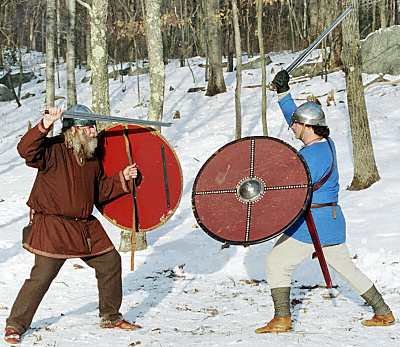 |
That is not to say that the flat of the shield was never used for parrying a weapon in the Viking age. Surely, a warrior would parry with whatever was available in the heat of battle. Kári had just finished cutting a man in two when Lambi cut at Kári with his sword, as told in chapter 150 of Brennu-Njáls saga. Kári parried the attack with the flat of his shield. That the saga author found this notable enough to mention suggests that perhaps this usage of the shield was not common. The author also comments that Lambi's sword did not "bite" the shield, again, suggesting that perhaps a different outcome was expected. Kári's parry was successful, and he thrust though Lambi's chest, killing him.
|
Another approach to using a Viking shield has recently been suggested, similar to the peek-a-boo guard used by modern boxers. The shield is held up near the head, with the shield hand near the face. The position provides significant protection to the head and to the all-important central nervous system. |
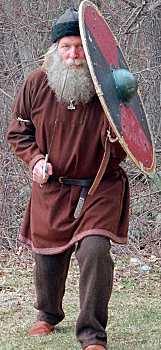 |
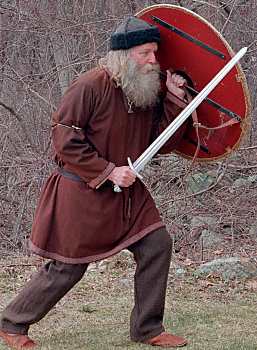 |
The grip is very efficient in its use of body resources, since the weight of the shield is locked in place and carried by the skeletal system rather than being held in place by the muscles of the arm and shoulder. The shield is moved for defense using small motions of the arm and hip, making for extremely fast parries from either side, with little effort. The orientation of the shield grip with the hand and wrist, along with the large contact area with the body means the shield is much more solidly positioned against incoming strikes, making it less likely to be hammered out of position. Additionally, when the shield edge is used offensively (as discussed later in this article), a twist of the hips applies the power from the strong muscles of the lower body to the strike, making for a devastating attack. |
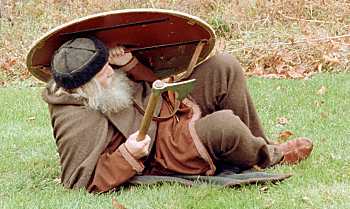 |
This high shield position has many advantages when fighting from the ground, as well, after a fighter has been wounded or otherwise forced down. Virtually the entire body is shielded. Visibility is good, and many attacks are still possible. |
Yet, this approach to using the shield has many problems not yet resolved. It's more difficult to defend against low attacks. It's easy to blind oneself to an opponent during some defenses. Additionally, the shield takes a lot of abuse from the opponent's weapons in this position.
Yet the advantages of this approach to shield use, both in speed and efficiency, are so significant that we are reluctant to discard it out of hand. Perhaps one shield position was used for close-in fighting, and another for more distant fighting. Our research continues.
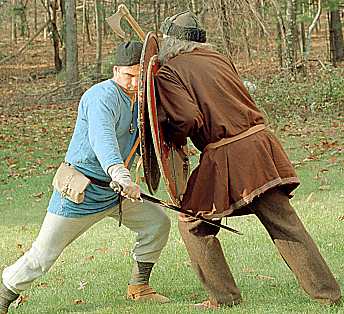 |
One example of the aggressive defensive use of the shield is binding the opponent's weapons, opening a new line of attack. By sweeping his shield from outside to inside across his front, a combatant can capture and trap his opponent's weapons with his shield, leaving the opponent open to an attack (right). This kind of shield bind can also be used to apply pressure to the opponent's body, allowing control of his movements. In the photo to the left, Brown has put Blue in a poor shield bind. Brown controls Blue's body with his shield bind, but Brown has neglected to control Blue's weapons. Blue is about to give Brown a lesson in the importance of maintaining that control. |
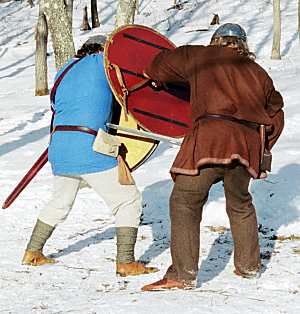 |
The futility of hiding behind a shield as if it were a wall is graphically illustrated in this series of photographs.
|
Test cuts were made, using a replica Viking axe against a replica Viking shield. The shield was made of six wooden planks, butted and glued together. The overall diameter of the shield was 84cm (33in), and the thickness was uniformly 13mm (1/2in). The planks were Quaking Aspen (Populus tremuloides), a hardwood having similar properties to Basswood (Tilia, also known as Linden outside of North America). The boss was attached to the front by clinched forged nails, and the handgrip was similarly attached to the back. A rawhide edging was attached to the rim by tacks. No iron reinforcements were used on the back, and no facing was used on the front. The shield was affixed to a wooden stand that simulated a human grip on the shield. |
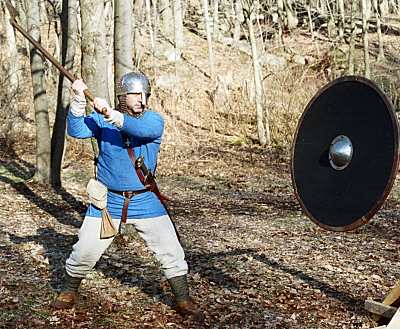 |
|
A cut was made from a ward without a wind-up, as one might do in a combat situation. The axe penetrated the shield easily. |
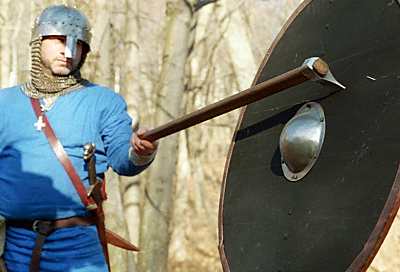 |
|
The axe split the plank from one end to the other, and the fragments were held in place by the rawhide edging. |
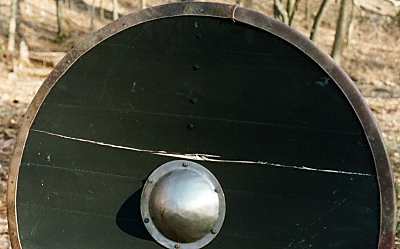 |
|
If a hand had been holding the shield when the blow struck, the axe would have partially severed the hand. |
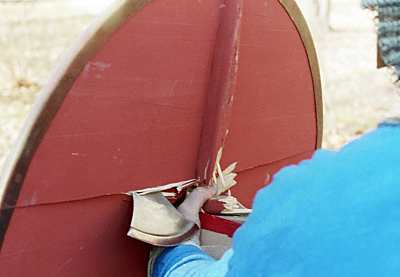 |
|
With the second blow, the shield was destroyed. Again, the plank was split from end to end, and the rawhide edging failed. The handgrip broke in several places, and the shield fell apart. |
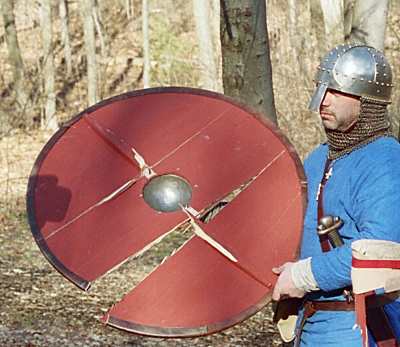 |
|
The same test was made on an identical shield that was faced with leather. 1mm (2oz) leather was glued to the front surface of the wooden planks. |
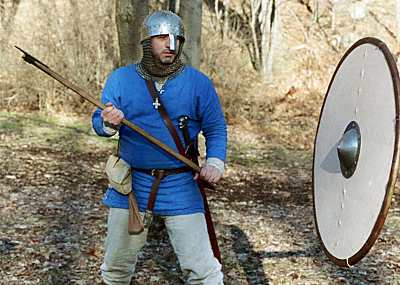 |
|
The first blow penetrated the shield, but did not split the planks. There was no damage to the shield, other than the penetration, and the shield remained an effective defense. |
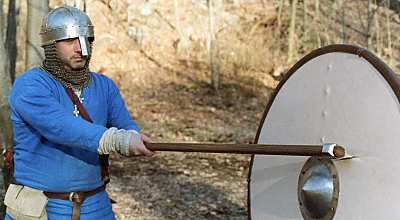 |
|
Even after four solid blows, the shield was still intact, without any splits. It remained a solid, usable defense, demonstrating the benefit of a facing on shield. It wasn't until the sixth blow that the shield failed, due to the shattering of the handgrip. This failure suggests that a solid iron reinforcement would be beneficial for extending the utility of the shield faced with leather. |
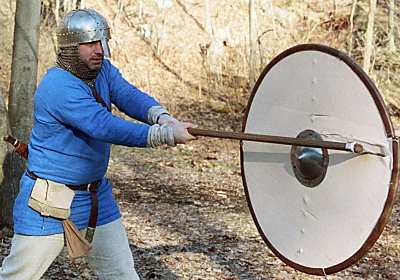 |
|
We also did the same test on an unfaced plied shield, built according to the Gulaţing laws, with iron reinforcing bars on the back. A slow motion video of one of the axe blows may be seen here. The benefits of using a shield constructed of layers of wood compared to a shield contructed of planks is clearly visible in the photos to the right. The unfaced planked shield offers little protection after just two hits, while the unfaced plied shield continues to offer significant protection, even after it had been penetrated by an axe five times. |
|
|
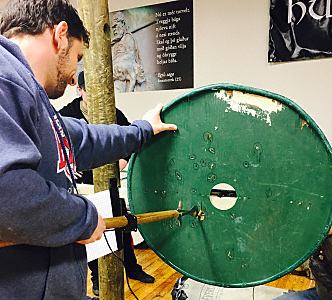 |
More recent experiments with spears continues to show the advantages of a plied shield compared to a planked shield. The unfaced plied shield (left) was pierced many dozens of times with a spear and remained intact, while the unfaced planked shield (right) flew apart into pieces on the second hit, with shards of wood and rawhide edging flying in all directions. |
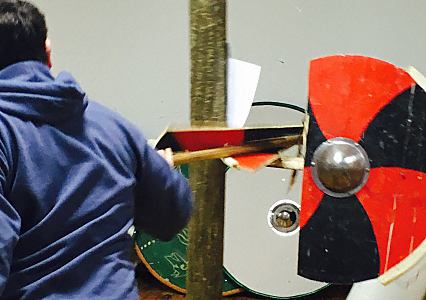 |
Further research and tests are planned. Would a hand have been able to hold a shield given this kind of impact? Would bones have broken under the force of the blow? What are appropriate responses for each combatant when a weapon penetrates and is trapped by the shield, which happened several times during these test cuts?
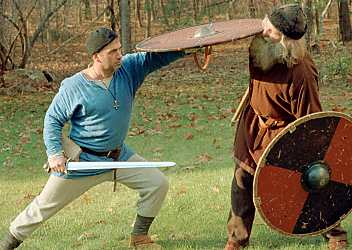 |
In addition to its obvious defensive uses, the shield can also be used offensively. The edge of the shield can be used for punching, turning it into a very effective set of "brass knuckles". If a combatant does not take care to control his opponent's shield, he may quickly find his teeth have been knocked out. The attack can be made with the arm and shoulder, or very powerfully and quickly using the hips. In chapter 32 of Bjarnar saga Hítdćlakappa, Björn drove his shield into his opponent's head to kill him. Using the high shield position described earlier on this page, it's easy to imagine delivering a lethal one-handed punch with the edge of the shield. However, the saga suggests that Björn used two hands. A speculative reconstruction of this move is shown in this combat demo video, part of a longer fight. |
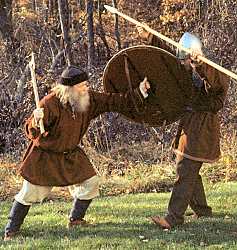 |
|
In an extreme case of offensive shield use, Grettir kicked Snćkollr's shield up into his head so hard that Snćkollr's face ripped open and his jaws fell down to his chest, as is told in chapter 40 of Grettis saga. A speculative reconstruction of this move is shown in this combat demo video, part of a longer fight. |
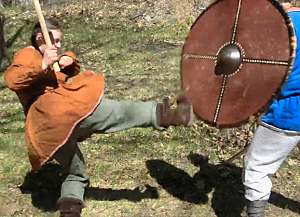 |
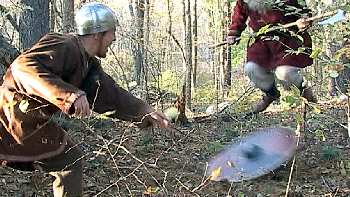 |
The battle on the ice on the Markarfljót is described in chapter 92 of Brennu-Njáls saga. As Skarpheđinn slid across the frozen river, Tjörvi flung his shield at Skarpheđin's feet, hoping to trip him. Skarpheđinn merely jumped over the shield and continued gliding across the frozen river to place his axe in Ţráin's skull. A speculative reconstruction of that move is shown to the left, and in this combat demo video, part of a longer fight. Hurstwic has conducted research on how and when a Viking warrior might choose to throw his shield, detailed in this short video. |
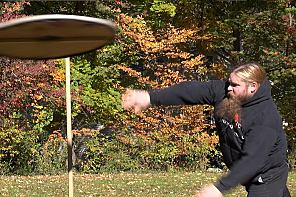 |
|
A fighter might run in under an opponent and bash him or smother him with his shield, shown to the right and in the same combat demo video. |
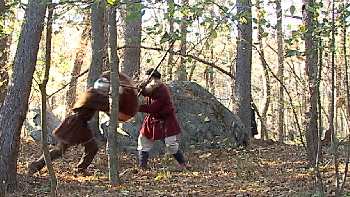 |
|
The stories also describe instances where the shield was used completely passively. Shields were thrown on fallen combatants during a battle to protect them from further injury. In chapter 150 of Brennu-Njáls saga, Kári threw a spear at Grani, which pierced his thigh and pinned him to the ground. His companions freed Grani and laid him in a hollow and covered him with shields. A swimmer under attack from missiles thrown from the shore might cover his back with his shield to protect himself while swimming. In chapter 26 of Bjarnar saga Hítdćlakappa, Björn did just that while swimming across the Hítará to escape an ambush by Ţórđr and his men. The ambush took place on the Hítará in the general area shown in the photo to the right. |
 |
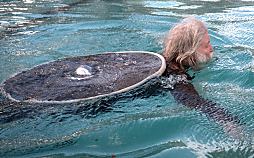 |
We tried this to test whether it was possible to swim with a shield on one's back, and whether the shield provided any protection. Swimming with a shiled while wearing Viking clothing was no problem. The shield seemed to provide some significant protection to the swimmer from arrows fired from the land, although the archers commented that the shield made the swimmer a better target. |
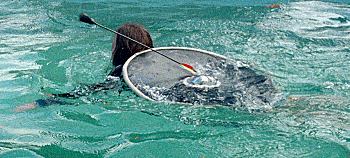 |
The stories suggest that slaves were used as human shields. In chapter 23 of Víga-Glúms saga, Glúmr fell in battle. His two slaves threw themselves on his fallen body to shield him. The slaves were both killed, but Glúmr survived.
Shields were used as barriers, to surround opponents and subdue them, as described in chapter 89 of Brennu-Njáls saga. While fighting against Earl Hákon and his men, the sons of Njáll were encircled by Sveinn and his men, who penned them in with their shields. The earl ordered the captured men killed at once, but Sveinn demurred, pointing out that it was night, when men should not be killed. The captives were bound, and later in the night, they were able to cut their bonds and escape.
During a recent practice, I discovered what should be obvious: a shield makes an excellent sail. A gusty wind makes controlling the shield very much more difficult. One wonders if a skilled fighter would take advantage of that in the same way he might contrive to put the sun in his opponent's eyes.
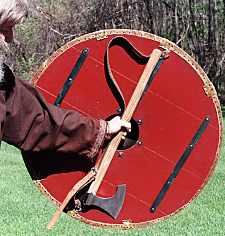 |
The stories say that a fighter might hold a second weapon at the ready in his shield hand, while fighting with his primary weapon in the other hand. In chapter 12 of Fóstbrćđra saga, Ţorgeirr held a shield and an axe in his left hand while he fought with a spear in his right hand. Later in the fight, he threw down his spear and took up the axe in his right hand, using it to cut through Snorri's spear shaft, and then through Snorri's head. |
The use of shields was nearly universal in Viking combat. Someone without a shield would be, quite literally, defenseless, and would likely be cut down very quickly. So, most every fighting man had a shield.
The stories say that occasionally, some men chose not to carry a shield, notably when they carried a two-handed weapon, or a different weapon in each hand. Gunnar carried his atgeirr (halberd) in one hand and a sword in the other at the battle at Rangá described in chapter 63 of Brennu-Njáls saga. Thinking him defenseless, Ţorgeirr urged his brothers Börkr and Ţorkell to all charge at Gunnar together. "He has no shield, and we'll have his life in our hands." Gunnar had other ideas, and he knocked Börk's sword out of his hand with his atgeirr while slicing off Ţorkel's head with his sword.
Ţormóđr prepared for a battle, as told in chapter 24 of Fóstbrśđra saga. He carried a sword and an axe, but no shield. Seeing that he had no shield, King Ólafr asked why he was not dressed for battle like other men. Did he think his opponents didn't know how to fight? Ţormóđr replied that his axe would serve as both his shield and mail shirt.
Since the shield could and did break in combat, people expecting to be in a protracted fight such as a duel might have several shields on hand. The sagas are filled with examples in which shields split or punctured under the force of incoming spears, axes, or swords. While fighting Gunnar in chapter 43 of Grettis saga, Atli delivered a blow with his sword that sliced through Gunnar's shield and part of Gunnar's knee. Atli's next blow killed Gunnar.
Shields were treated differently than other weapons, perhaps because they were so disposable. Shields apparently were not named, in the way that swords, mail, and other weapons were.
Shields had uses outside of combat. Elaborately decorated shields were given as gifts. In Egils saga (chapter 81), the earl gave the poet Einar a shield that was carved with scenes from legends, overlaid with gold, and set with jewels.
Shields were used as decorations inside the longhouse. Later in Egils saga, Einar took the shield and left it as a gift for Egill, hanging it on the wall above his bed. In Egils saga (chapter 11), Ţórolfr held a great feast for the king. So many people were invited that Ţórolfr had to install benches in a large barn so that there would be places for all the guests. Shields were hung on the walls for decorations.
Shields were used as stretchers, to carry away men wounded in combat. In chapter 24 of Ljósvetninga saga, Kođrán tried to stop a fight by separating the combatants. When he stepped into the fray, he was struck on the head with an axe. Kođrán was carried away on a shield and bandaged, but he died from his wounds in the night.
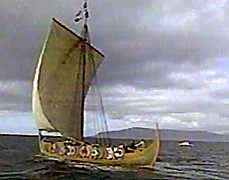 |
On board ship, shields were arrayed along the gunwales, providing some additional protection from wind and waves to the crew. The photos show the Íslendingur, a modern Viking ship reproduction, off the coast of Iceland as she began her voyage to North America in the year 2000. Hung along the sides, the shields interfere with the operation of the ship, so some believe shields were arrayed in this manner only to create an imposing appearance while entering or leaving harbor. |
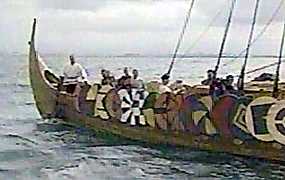 |
There are some students of Viking age fighting styles who say that a shield was the only defense needed, and that proper use of a shield makes other defenses (such as helmet and mail) unnecessary. Others would disagree, saying that even with a shield, the other defenses are necessary. However, since helmet and mail were expensive, due to the cost and limited availability of iron, there were probably many combatants using only a shield for defense.
|
|
<< Previous article |
Back to Arms and Armor |
Next article >> |
|
©1999-2025 William R. Short |